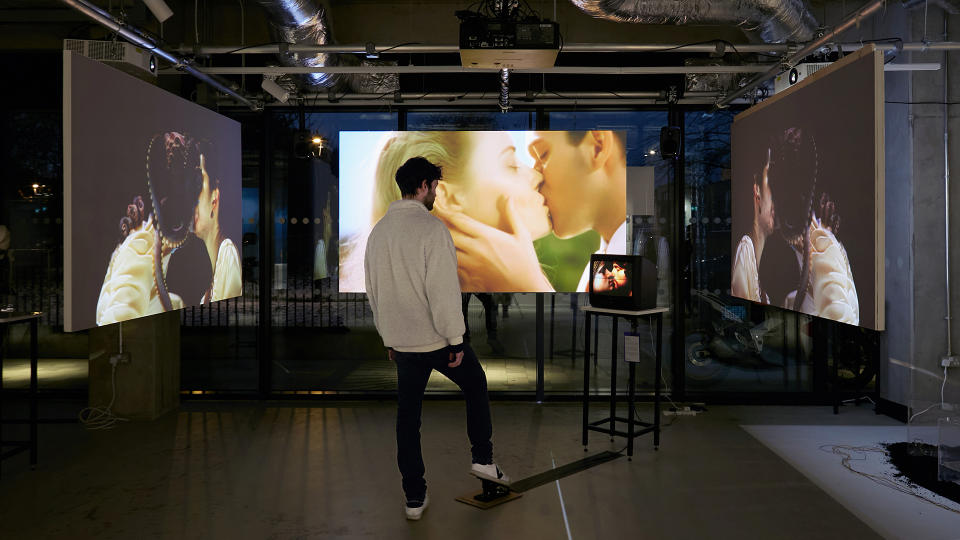Sex and Car Crashes Collide in AI Short from a Filmmaker Who Feared AI

For the hundreds of talks and demonstrations of artificial intelligence at SXSW 2024, few moving-image projects at the festival utilized AI. Of the dozen or so, Adam Cole’s “Kiss/Crash” installation at the festival’s well-curated, multi-floor exhibition XR Experience felt the most traditional, especially for an audience familiar with museum video exhibitions or experimental shorts.
Cole’s black-box exhibit centers on a short film (watch it below) that features a montage of romantic kissing, juxtaposed and melded with dated stock video of two cars colliding. The automobiles then reverse in slow motion and then smash into each other again, and again. As the pacing intensifies, the imagery grows increasingly sexual to the point of pornography, all while Ritchie Valens’ 1958 track “We Belong Together” keeps the imagery grounded in a dreamy 1950s sway that would make David Lynch happy.
More from IndieWire
At the SXSW Film & TV Festival award ceremony March 12, “Kiss/Crash” received the Audience Award for the XR Special Event category. Like any experimental film, its ideas are inseparable from the choice of the medium and form.
“I think there’s a really interesting question of, ‘Why use AI at all for this project?’” said Cole, acknowledging there were other ways to get similar results. “This whole work was motivated by this massive anxiety around AI image generation.”
Watch “Kiss/Crash” in the video below:
Video images released from OpenAI’s Sora last month inspired Hollywood panic. Cole knows the feeling. As a digital media designer, he experienced it in 2021 with the release of OpenAI’s DALL-E.
“I was, like, absolutely terrified by it,” said Cole, recalling the DALL-E generated images of a teddy bear on a skateboard that sent him into existential dread. “I felt like, ‘Where does art go from here?’ Which was a bit maybe overdramatic.”
Lucky for Cole, he also was studying for his masters at the Creative Computing Institute at the University of the Arts London.
“I got some good advice from my advisor,” said Cole. “He [said], ‘We’ll do what artists have always done.’ By which he meant we will take these technologies and we will twist them, and open them up, and break them, to do something interesting with them. That helped give me a bit more context.”
Cole started to see AI through a different lens, specifically the history of cinema and photography.
“What I started to realize is we talk about these technologies like they’re so radically new, like they came from nowhere, but we’ve been dealing with artificial images for 100 years,” said Cole.
“Kiss/Crash” connects AI to this tradition as the project explores the expanding gap between real experiences and artificial simulations.
“We talk about these images like they’re quite flimsy, like they’re ephemeral and have no impact,” Cole said, reflecting on how Hollywood’s Dream factory shaped his own sense of what romantic love looks like. “They actually have this incredible power to define our perception of reality, conform our desires, and to invent our fantasies.”
Cole’s film suggests AI will only perpetuate archetypes engrained in these images. The SXSW exhibit projects a potentially dangerous future where of our perception of what true love looks like, what romance looks like, and what will happen to our desire in the shadow of AI. The installation also included two smaller television screens to the sides of the main movie, and a foot pedal that spectators could use to control the montage’s speed and sexual intensity.

“The interactive element was important for me [because] you already have this voyeuristic relationship with images,” said Cole. “The foot pedal gives us suddenly some agency over this connection to these images, kind of mimicking that incredible hunger for more extreme content that we’re all so familiar with in online digital worlds.”
While making “Kiss/Crash” gave Cole an outlet for his AI anxiety, his exploration of the ideas also scared him in new ways. Watching people floor the gas pedal suggested how AI could throw gas on an already-blazing fire as we move toward extreme simulations further removed from from our lived experiences.
Cole used AI video translation to morph the existing video and alter its shape and contours so the kisses meld with the colliding cars. The visual metaphor surrounding the pleasure of destruction doesn’t require understanding AI.
“When I first saw that [image manipulation] capability, my first instinct is, ‘What does it mean that we can now invert the meaning of images?’” said Cole. “It can have the same shape and look, but you can totally change the meaning.”
To create the project, he built an AI tool based on a stable diffusion model. He fed it a data set of classic Hollywood romance scenes, fine tuned with code he pulled from open-source tools. Cole’s AI tool and its results were hailed as a breakthrough at SIGGRAPH last year.
Cole is more intellectually comfortable with his AI tool, which required traditional post software to finish the project. However, he sees how other filmmakers might have trouble following in his footsteps: He has the technical background that allows him to create bespoke models with open-source tools.
While there’s plenty of online forums to provide that education, for most filmmakers that’s a stumbling block if they want to work with AI. “You can’t get these kind of images from private companies,” Cole said. “They censor and they limit it, and they’re hiding stuff.”
You can learn more about Cole’s work, including experiencing an online version of the “Kiss/Crash” installation, here.
Best of IndieWire
Sign up for Indiewire's Newsletter. For the latest news, follow us on Facebook, Twitter, and Instagram.

 Yahoo News
Yahoo News 
